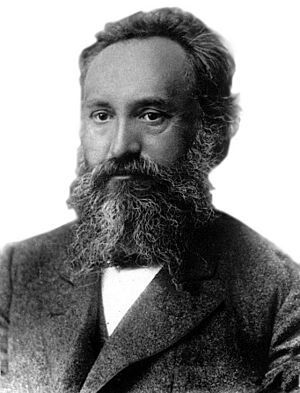Evgraf Fedorov facts for kids
Quick facts for kids
Evgraf Fedorov
|
|
|---|---|

Evgraf Stepanovich Fedorov
|
|
| Born | 22 December 1853 Orenburg, Russian Empire
|
| Died | 21 May 1919 (aged 65) |
| Known for | Fedorov groups Fedorov's theorem |
Evgraf Stepanovich Fedorov (Russian: Евгра́ф Степа́нович Фёдоров, December 22, 1853 – May 21, 1919) was a brilliant Russian scientist. He was a mathematician, a crystallographer, and a mineralogist. He is famous for his important discoveries about how crystals are built.
About Evgraf Fedorov
Evgraf Fedorov was born in the city of Orenburg in the Russian Empire. His father was an engineer who made maps. The family later moved to Saint Petersburg. From age 15, Evgraf loved studying polytopes. These are 3D shapes with flat sides, like cubes or pyramids. This became his main interest.
He studied at the Gorny Institute. He joined when he was 26 years old. He was a very good student there. Later, in 1905, he became the first leader of the Institute.
His Big Discoveries
Evgraf Fedorov made huge steps in understanding crystals. He studied their inner structure. In 1891, he figured out that there are exactly 230 ways that atoms can arrange themselves in a repeating pattern to form a crystal. These are called space groups. This discovery is super important for X-ray crystallography. This is a method scientists use to see the exact structure of materials.
He also proved that there are only 17 different ways to tile a flat surface perfectly. Think of patterns on wallpaper or floor tiles. These are called wallpaper groups. Another scientist, George Pólya, proved this independently later.
In 1895, Fedorov became a professor of geology. He taught at the Moscow Agricultural Institute. He died in 1919 from pneumonia. This was during the Russian Civil War.
The Fedorov Stage
Evgraf Fedorov also invented a special tool. It is called the Fedorov stage. This tool is used with polarizing microscopes. It helps scientists study mineral samples very carefully. They can tilt and spin the sample at exact angles. This helps them understand the crystal's structure better.
Legacy
There is a street named after Evgraf Fedorov. It is located near Hamburg, Germany. This street is at the site of a big science facility. It is called the European XFEL. This facility uses X-ray lasers for research.
See also
- Group theory
- List of Russian material scientists
- Parallelohedron
- Zonohedron
Images for kids


